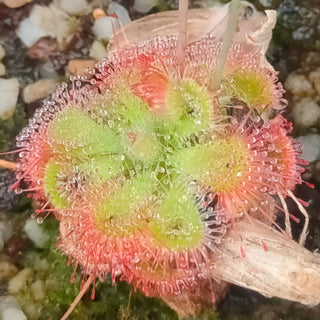Drosera intermedia
SPOONLEAF SUNDEW
- Unit price
- / per
Drosera intermedia, commonly known as the oblong-leaved sundew, spoonleaf sundew, or spatulate leaved sundew, is an insectivorous plant species belonging to the sundew genus. It is a temperate or tropical species native to Europe, southeastern Canada, the eastern half of the United States, Cuba and northern South America.
Drosera intermedia is a perennial herb which forms a semi-erect stemless rosette of spatulate leaves up to 10 cm tall. Plants in temperate regions undergo dormancy during which they form a winter resting bud called a hibernaculum.
As is typical for sundews, the leaf blades are densely covered with stalked mucilaginous glands which secrete a sugary nectar to attract insects. These then become ensnared by the mucilage and, unless they are strong enough to escape, are suffocated or die from exhaustion. The plant then secretes digestive enzymes from sessile glands and later absorbs the resulting nutrient solution to supplement the poor mineral nutrition of the plants natural environment.
Drosera intermedia blooms from June through August, forming up to 15 cm. tall inflorescences bearing 3-8 white flowers. Fertilized ovaries swell to form egg-shaped dehiscent seed capsules which bear numerous small seeds.
Drosera intermedia is one of the most widely distributed species in the genus, and one of only three Drosera species native to Europe (the others are D. rotundifolia and D. anglica). It is also found in eastern North America, Cuba, and northern South America. The Cuban and South American forms are tropical and do not form hibernacula in the winter.
Drosera intermedia grows in sunny, but constantly moist habitats including bogs, fens, wet sandy shorelines and wet meadows. Since it is carnivorous, it is able to occupy relatively infertile habitats including wet sand and peat.
Note: These seeds are extremely tiny! It's just how they naturally are. Reading glasses are recommended to aid with seeing them, even for those who don't normally require glasses to read. The seeds are shipped in either a wax envelope, or folder within a small paper. Open carefully, and sprinkle onto the growing medium. Do not bury the seeds. Germination information is below.
Type: Hardy perennial
Hardiness zones: 6-9
Seed origin: Ontario, Canada
Seeds per pack: 10
Fill the container with a mix of peat and perlite at a 1:1 ratio. Place the seeds on the surface of the pre-dampened mix, and gently water with a spray bottle. Cover with clear plastic, and place your container in a cool area (but not freezing) for 6 weeks. Once the cold period is completed, place the container at room temperature (20C/71F) and in bright light for them to germinate. Be sure to keep the soil moist during this entire germination period. Most seedlings will sprout within 2-3 months of the warming period, though some may take a little longer. Once plants sprout, slowly remove the plastic, a little bit each day. Always keep the soil slightly moist, never letting it dry out.
Drosera intermedia
SPOONLEAF SUNDEW
- Unit price
- / per
Multiple secure payment options available.
Adding product to your cart
You may also like
Drosera intermedia, commonly known as the oblong-leaved sundew, spoonleaf sundew, or spatulate leaved sundew, is an insectivorous plant species belonging to the sundew genus. It is a temperate or tropical species native to Europe, southeastern Canada, the eastern half of the United States, Cuba and northern South America.
Drosera intermedia is a perennial herb which forms a semi-erect stemless rosette of spatulate leaves up to 10 cm tall. Plants in temperate regions undergo dormancy during which they form a winter resting bud called a hibernaculum.
As is typical for sundews, the leaf blades are densely covered with stalked mucilaginous glands which secrete a sugary nectar to attract insects. These then become ensnared by the mucilage and, unless they are strong enough to escape, are suffocated or die from exhaustion. The plant then secretes digestive enzymes from sessile glands and later absorbs the resulting nutrient solution to supplement the poor mineral nutrition of the plants natural environment.
Drosera intermedia blooms from June through August, forming up to 15 cm. tall inflorescences bearing 3-8 white flowers. Fertilized ovaries swell to form egg-shaped dehiscent seed capsules which bear numerous small seeds.
Drosera intermedia is one of the most widely distributed species in the genus, and one of only three Drosera species native to Europe (the others are D. rotundifolia and D. anglica). It is also found in eastern North America, Cuba, and northern South America. The Cuban and South American forms are tropical and do not form hibernacula in the winter.
Drosera intermedia grows in sunny, but constantly moist habitats including bogs, fens, wet sandy shorelines and wet meadows. Since it is carnivorous, it is able to occupy relatively infertile habitats including wet sand and peat.
Note: These seeds are extremely tiny! It's just how they naturally are. Reading glasses are recommended to aid with seeing them, even for those who don't normally require glasses to read. The seeds are shipped in either a wax envelope, or folder within a small paper. Open carefully, and sprinkle onto the growing medium. Do not bury the seeds. Germination information is below.
Type: Hardy perennial
Hardiness zones: 6-9
Seed origin: Ontario, Canada
Seeds per pack: 10
Fill the container with a mix of peat and perlite at a 1:1 ratio. Place the seeds on the surface of the pre-dampened mix, and gently water with a spray bottle. Cover with clear plastic, and place your container in a cool area (but not freezing) for 6 weeks. Once the cold period is completed, place the container at room temperature (20C/71F) and in bright light for them to germinate. Be sure to keep the soil moist during this entire germination period. Most seedlings will sprout within 2-3 months of the warming period, though some may take a little longer. Once plants sprout, slowly remove the plastic, a little bit each day. Always keep the soil slightly moist, never letting it dry out.





















































